 Soda Wars: Now playing in your local drugstore’s freezers.
Soda Wars: Now playing in your local drugstore’s freezers.
It’s no great mystery that millennials love self-expression. The idea that their unique self can be captured in every brand interaction and demonstrated through every purchasing decision is the driving force behind how many brands market to millennials.
In 2014, Coca-Cola challenged the world to “Share A Coke.” In 2016, two new brands joined the chorus, first Pepsi in February with “Say It With Pepsi,” and Dr. Pepper in June with “Pick Your Pepper.”
While the three campaigns diverge in a number of ways, at their cores they’re attempting the same thing – a way to make soft drinks personal.
“Share A Coke”
Started in 2014, “Share A Coke” is arguably the inspiration for the other two campaigns. The campaign started with common names being found on select Coke products, followed by “nicknames” like BFF, Buddy, Wingman, etc. The campaign then toured the nation allowing people to punch in their names on a screen and get two customized mini cans of Coke. The “Share A Coke and A Song” summer campaign that features lyrics in the place of names is also a throwback to the iconic 1971 Coke commercial, “I’d Like to Buy the World A Coke” where Coke lovers gather on a hilltop in song.
This is what makes “Share A Coke” such a success compared to the other two facsimile campaigns: It’s timeless. A name is personal, independent of generational gaps; a song lyric can be from 1972 (“Lean on Me”) or 2005 (“It’s Getting Hot in Herre”); and even nicknames like the contemporary “bestie” or a more subdued, “someone nice” refuse to alienate their consumers by age.
“Say It With Pepsi”
The “Say It With Pepsi” campaign features one of over 600 Pepsi-created emojis alongside the usual Pepsi globe on Pepsi product labels. The drawback for Pepsi’s emoji-driven campaign is that it has limited opportunities for personalization. While there are 600+ “PepsiMoji” designs, that’s it. With opportunities to swap and combine design elements, options for genuine self-expression are much greater with the Coke and Dr. Pepper campaigns.
“Pick Your Pepper”
The goal for Dr. Pepper’s “Pick Your Pepper” campaign is for fans to “celebrate their individuality and find a label that best fits their personality, mood or passion.” The campaign features hundreds of different labels that are inspired by different “passion points.” Categories like 90s Retro Fan, Cat Lover and Gamer capture a very specific niche. So even though the labels aren’t as individualized as say, names, they are far more personal (and individual-focused) than a simple emoji.
The Rankings
In the end, what we have here are three variations on a theme.
Coke is a classic. Its approach to customization is understated, universal and timeless. It’s personalized in the most intimate of ways, through names and lyrics. The Coke campaign successfully navigates generational gaps, avoiding alienating either teens or grandparents.
Pepsi is riding a fad. The emojis might be fun to look at for some, but they don’t convey anything particularly unique about the person who drinks from that bottle. Sure, emotions are universal – but intimate? Not so much. And despite Pepsi owning 600+ custom emojis, they all look like same ones we’ve seen before.
Finally, Dr. Pepper is creating a fad. Dr. Pepper knows its campaign won’t enjoy the timeless success of Coke. But it does have a gamified approach that perfectly poises the campaign to catch on for a while, as people share GIFs across social media platforms. More than this, the way in which Dr. Pepper can be customized caters directly to the millennial crowd. It also provides an outlet for self-expression, as it’s the most customizable of the three. The labels are cute, fun and different, though the success of the campaign depends also on distribution and marketing.
In this particular matchup, Dr. Pepper gets points for innovation and Coke for tact – making it a tie for first with Pepsi sliding in (still) third.
Posted By
Categories
Consumer Campaigns